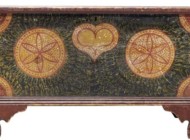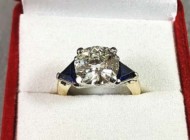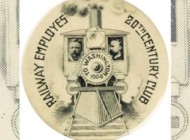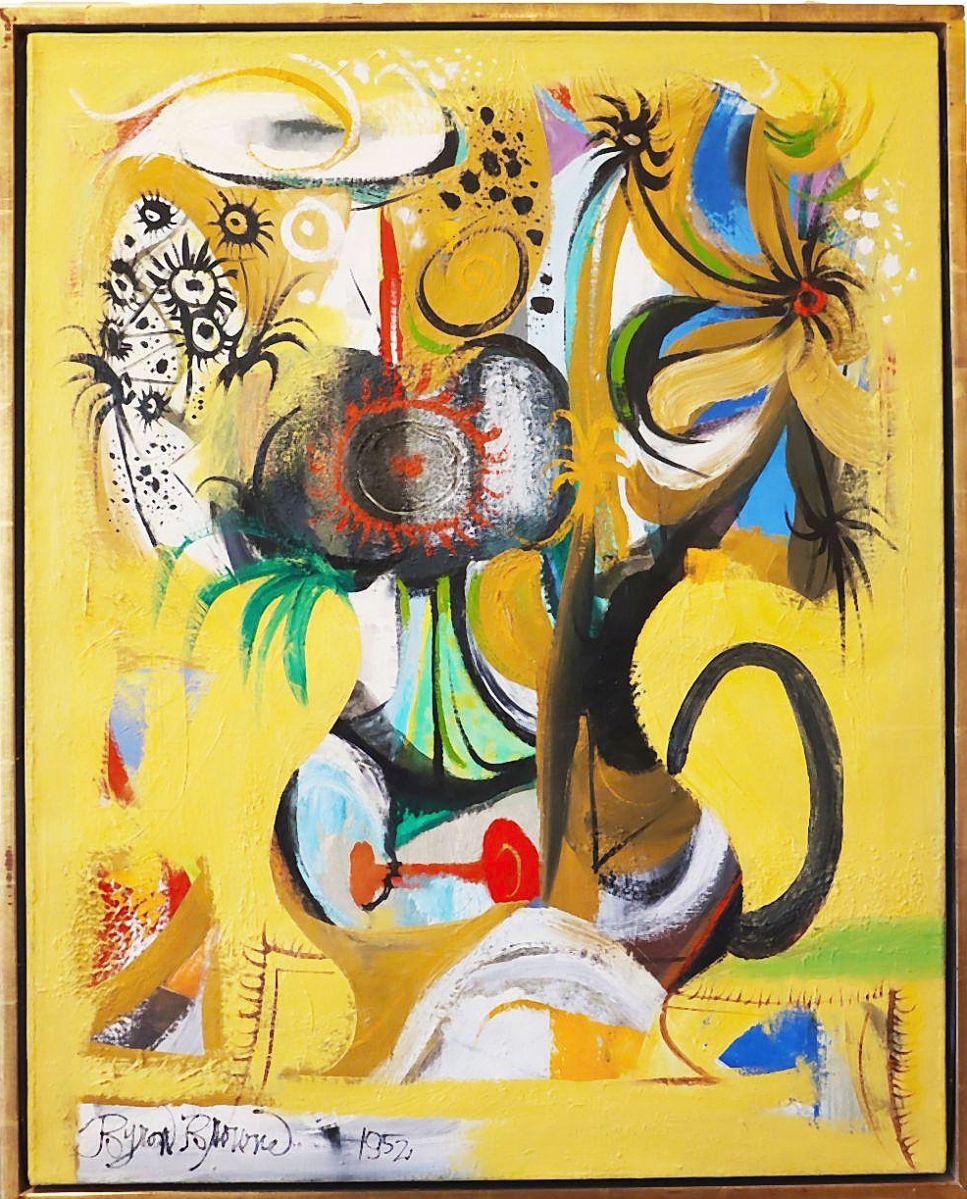
The top lot in the sale was “Sphinx” by George Byron Browne (1907-1961), which had come from a Sarasota estate. A buyer in Palm Beach, bidding online, took it to $19,530 ($20/25,000).
Review by Madelia Hickman Ring, Photos Courtesy Sarasota Estate Auction
SARASOTA, FLA. – “It was a long two days, but we had a great sale, and we were pleasantly surprised, with many lots toppling their estimates. We’re very, very pleased.”
That was Andrew Ford, owner of Sarasota Estate Auction, which dispatched more than 1,500 lots of fine art and antiques on Saturday and Sunday, September 18-19. He noted that auctions of that size have become the norm for the firm, which has a devoted local following but captures the attention of a global audience bidding on four internet platforms. He reported an aggregate sale total of about $475,000, with lots going to buyers in 25 countries outside of the United States.
The top lot of the day was George Byron Browne’s (1907-1961), “Sphinx,” which realized $19,530. The catalog noted that Browne was a central figure in the modernist New York art scene in the 1930s and was a founding member of the American Abstract Artists. “Sphinx” had been done in 1952 and measured 31½ by 25½ inches in its frame. It came from a Sarasota estate and sold to a Palm Beach, Fla., buyer bidding online.
About 75 lots in the sale were from the Dunedin, Fla., mansion of cereal magnate, William Keith Kellogg (1860-1951). The house – which has been slated for demolition – was built in 1925 and many of the furnishings from the sale were, according to the auction catalog, custom made for the house. Of particular interest to bidders were a carved hardwood dining set that featured a 145-inch-long dining table and a set of eight chairs. The lot came with a temptingly low estimate of just $1/2,000 but after competitive bidding, it sold for $13,860. A marble top buffet table from the same dining room closed out at $11,970. Both sold to Florida buyers.
Not all the lots from the Kellogg Mansion were three dimensional. Eric Sloane’s view of the Manhattan skyline, viewed from one of the boroughs south of Manhattan, is the only example Ford could find of the subject matter, which is atypical of the pastoral views that make up the significant body of the artist’s work. It may have been painted during Sloane’s study at the Art Students League and sold for $2,772, a result Ford deemed “a good value.”

“That was one of the sleepers in the sale,” Andrew Ford said of “Balinese” by Arie Smith (1916-2016). With a few museums giving chase, it closed at $7,560 ($600/900).
Rounding out the sale’s leaderboard at $13,230, and garnering international interest in the process, was a 9-inch-tall gilt-bronze Chinese Tibetan Ming dynasty Buddha of Vajrasattva, that was inset with gems throughout. Ford said it had come from a local private collector and said it sold to a discernible – and probably international – buyer.
A California collection was Ford’s source for two works by two different Mexican artists: Olga Costa (1913-1994) and Arturo Estrada (b 1925). Both had been estimated at $400/600; a buyer in Mexico paid $9,450 for “Hongos (Mushrooms)” by Costa. It just beat out the $9,135 that another Mexican buyer paid for Estrada’s “En El Espacio,” which had been exhibited in 1968 at the Salon De La Plastica Mexicana at the Instituto Nacional De Bellas Artes. Ford was not particularly surprised at the result for either painting, saying “We’re seeing a real surge in sales of Latin American work.”
Ford said that a few institutions were interested in Arie Smit’s (Netherlands/Indonesia, 1916-2016) “Balinese,” a 13-by-13-inch acrylic on canvas. After heated bidding, the colorful waterfall painting brought $7,560, giving its $600/900 estimate a good soaking.
Landscapes were popular among bidders. A small impressionistic plein air oil sketch on board, made in 1918 by Frank Johnston (Canadian, 1888-1949), had at least three Canadian bidders in pursuit and Ford suspected it ended up there.
“The Canadian art market has really heated up in the last ten years. There are a tremendous number of Canadians who live here half the year,” he said.
The $7,560 realized for a view of Niagara Falls in winter by Peter Caledon Cameron (American, b 1852), which had provenance to Questroyal Fine Art in New York City, was a little short of expectations. Ford said it was going to a fine art collector in Manchester, N.H.
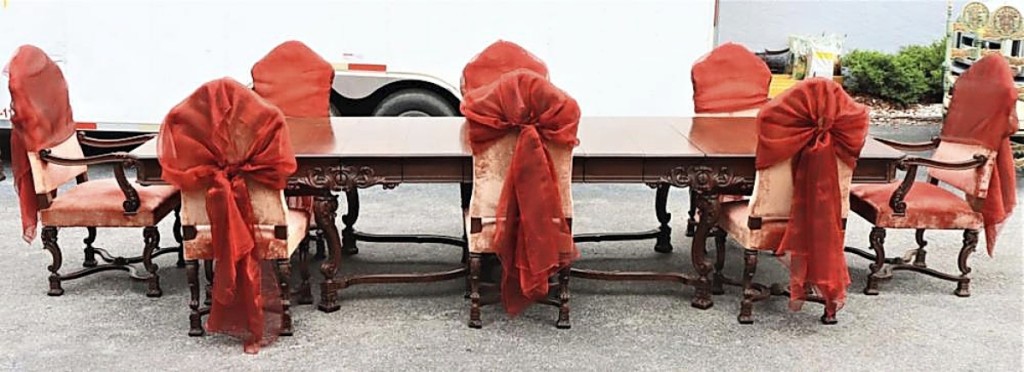
Leading nearly 75 lots from the Kellogg Mansion was this carved hardwood dining table and chairs, that had been made around 1925 when the mansion was built. A Florida buyer will be carting it off for $13,860 ($1/2,000).
Robert Swain Gifford’s 1871 image of the Rock of Gibraltar, an oil on canvas measuring 27 by 37 inches in a giltwood frame, brought $4,725.
One of the more unusual works in the sale was a patinated copper sculpture of a pelican wearing glasses and carrying a newspaper and an umbrella. Ford was not surprised that it flew past its estimate, landing at $3,150, going to a new home just a short distance from the auction house.
Interest often comes from countries where works originated. This was the case with an 84-by-28-inch Chinese scroll painting that bidders unrolled to $2,772; it is going back to China. A Russian buyer repatriated – for $2,646 – an Eighteenth or Nineteenth Century Russian icon of the Menava April Icon, from the Novrogod Iconographic school. According to the catalog entry, the icon had been housed in the Suhovatovskaya Church. Done in tempera and gold leaf on a wooden panel, it was described as “monumental” and measured 21½ by 18½ inches.
“We always get a good reception for local Florida art,” Ford said. “American Art Review recently did a spread on important Florida art and the Harn Museum of Art at the University of Florida in Gainesville recently got Samuel Vicker’s collection of Florida art; all of that has caused an uptick in interest in Florida art.” Markets follow research and create interest among collectors, so Ford was not too surprised that Paul Arsenault’s Florida coast scene titled “Whidden’s Marina,” appealed to local buyers. It brought $1,386.
Prices quoted include the buyer’s premium as reported by the auction house.
Sarasota Estate Auction’s next sale is scheduled for December 11-12.
For additional information, www.sarasotaestateauction.com or 941-359-8700.
















